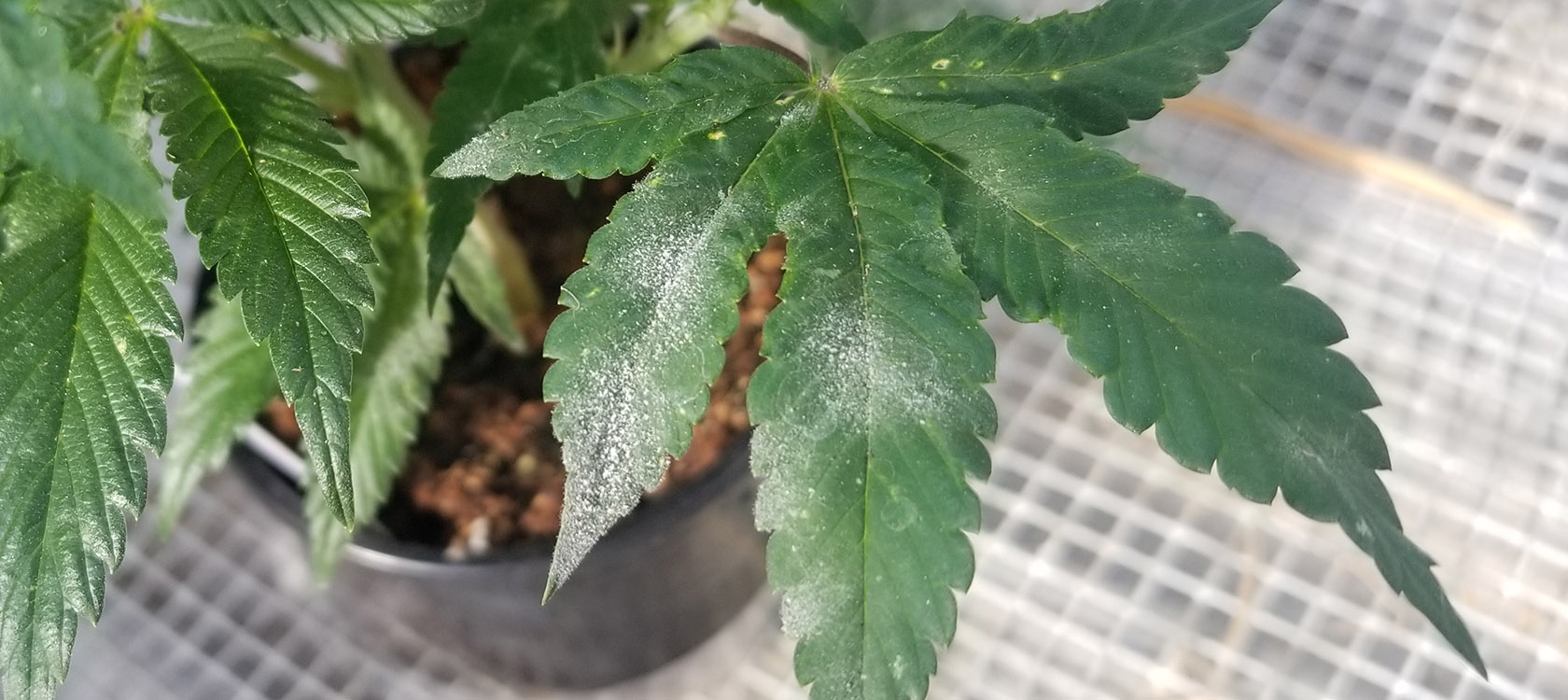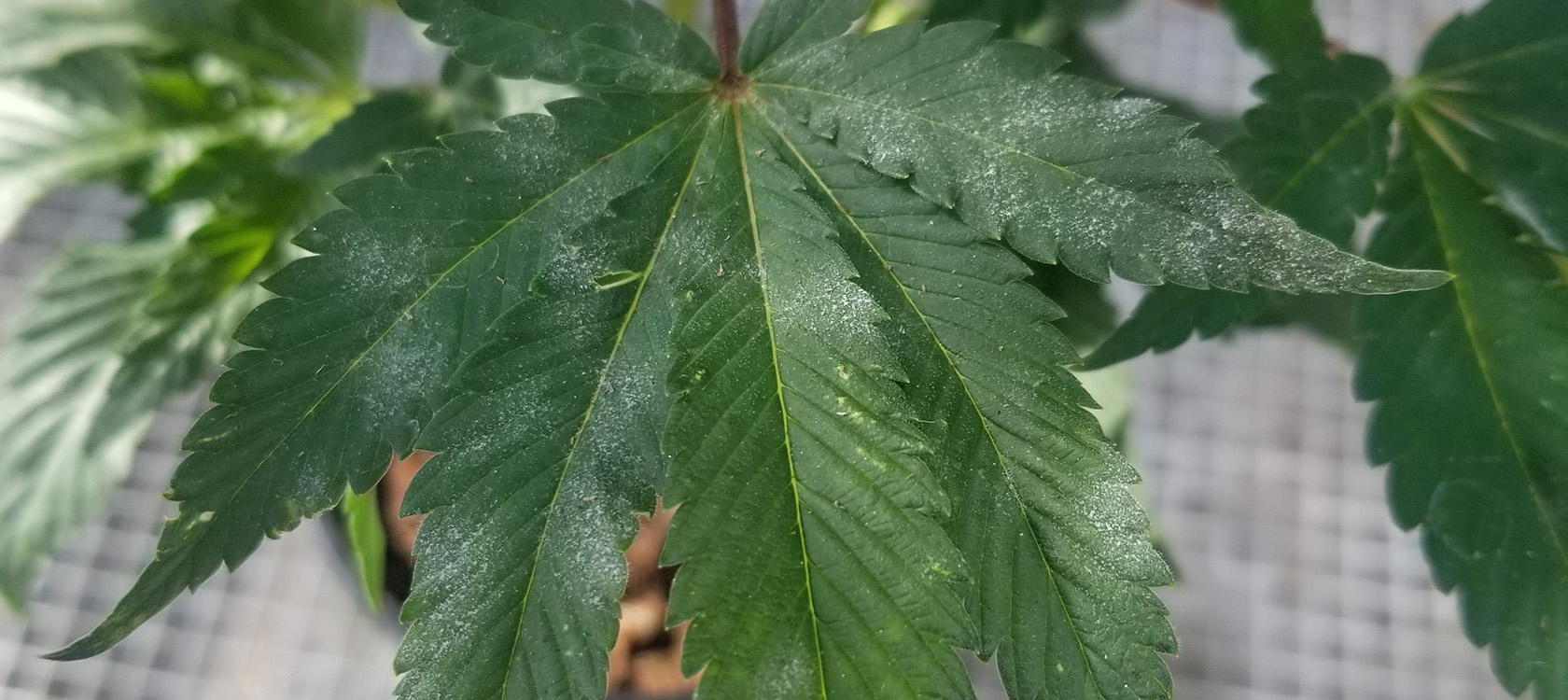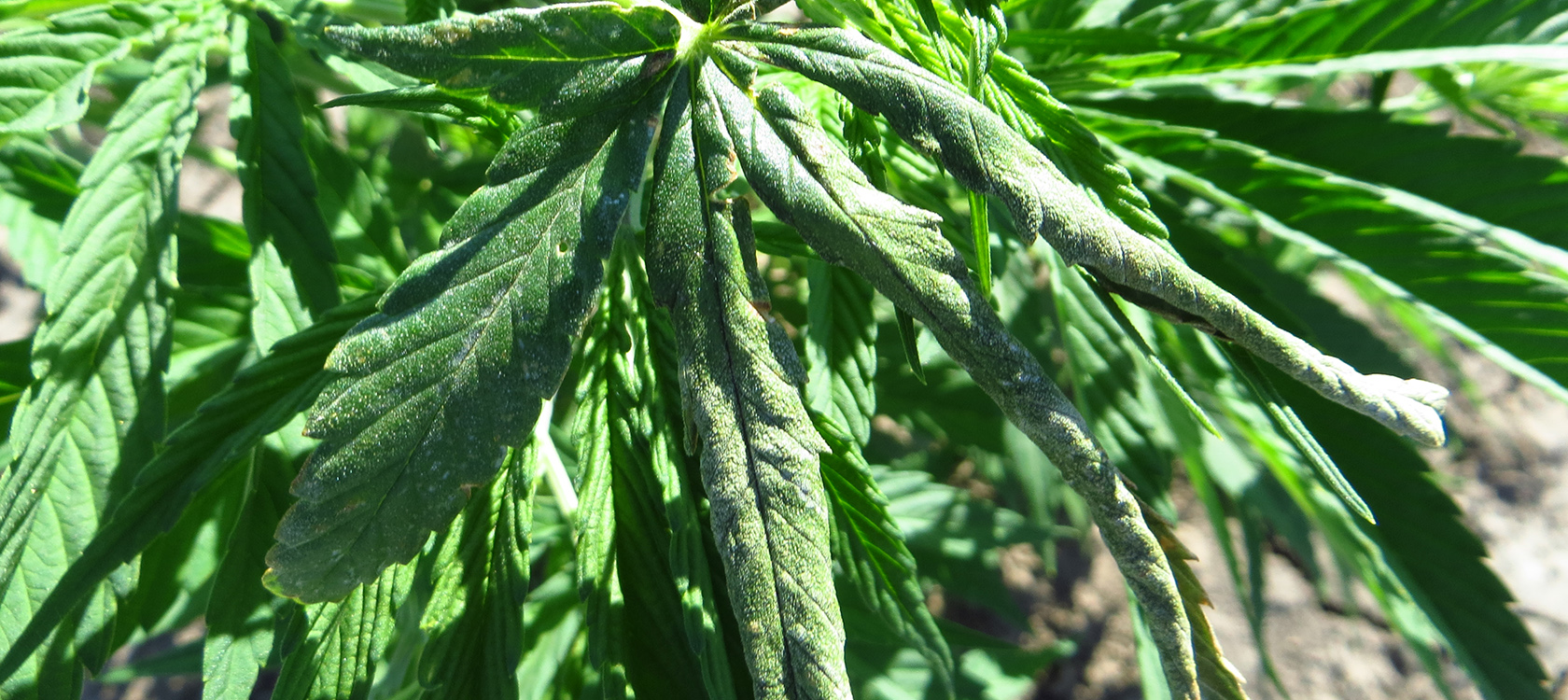Powdery Mildew
Golovinomyces ambrosiae
G. chicoracearum
Podosphaera macularis
 Powdery mildew with denser spotting on greenhouse-grown hemp.
Powdery mildew with denser spotting on greenhouse-grown hemp.

Powdery mildew with lighter spotting on greenhouse-grown hemp.
Hosts
- Hemp
- Bindweed
- Other crops
Additional information about hosts
- G. chicoracearum is found on bindweed and some ornamentals. However, there has been a debate if there are different strains of G. chicoracearum that are host-specific. To date, we have not seen G. chicoracearum on field-grown hemp in Utah despite bindweed nearby being covered with powdery mildew. This species has been found on greenhouse hemp.
- Another powdery mildew reported on hemp is P. macularis. It also infects strawberry and hops. Only
- G. ambrosiae has been found on field-grown hemp which also infects many cut flowers.
Symptoms
White, powdery spots that may expand to cover leaves, stems, or flower buds.
Disease Cycle
Powdery mildew survives as mycelium on green plant tissue in the greenhouse or outside in warmer climates. In colder climates it survives by producing, fruiting structures that contain overwintering spores (chasmothecia). As temperatures warm in the spring, the spores are released and colonize nearby green tissue. After colonizing the tissue, the characteristic white mycelium covers the tissue and new spores are produced. These spores cause new infections and the cycle can continue every 7 to 10 days as long as environmental conditions are favorable.
Time for Concern
Throughout the growing season.
When and Where to Scout
- Starting a few weeks after planting, inspect hemp leaves for new infections. Start with the lowest leaves of the plant, and check the undersides and the leaf surface for white, powdery areas.
Threat Level
Medium.
Occurrence in Utah
Powdery mildew on field-grown hemp has been very rare in Utah, but common on greenhouse hemp
Management
- Space out field or greenhouse plantings to allow for air circulation.
- Drip irrigation will lessen the chance of higher humidity, and reduce infection potential.
- Approved fungicides are available.
When to Consider Treatment
When scouting reveals that approximately 5 to 10% of plants are infested with powdery mildew. This is an estimate based on threshold levels for other crops, and has not been verified on hemp.
Look-alikes
None, as this disease is characteristic (white spots on leaves).
Fungicides for Powdery Mildew
| Utah-Registered Product | Active Ingredient(s) | Notes |
|---|---|---|
| BioSafe Disease Control RTU | hydrogen peroxide | |
| Bonide All Seasons Horticultural & Dormant Spray Oil Concentrate; Ready to Spray | mineral oil | Greenhouse use only (commercial). |
| Bonide Insecticidal Soap MultiPurpose Insect Control Ready To Use | potassium laurate | Greenhouse use only |
| Bonide Rose Rx 3 in 1 Concentrate | clarified hydrophobic extract of neem | Greenhouse use only. |
| Dr. Earth Final Stop OMRI Disease Control Fungicide (RTU); Concentrate | rosemary oil | |
| Jet-Ag | hydrogen peroxide | Cleans up spores but PM can come back in 7 days |
| Kopa Insecticidal Soap | potassiums salts of fatty acid | |
| Mammoth Cancontrol | thyme oil | |
| Natural Guard Brand by Ferti-lome Insecticidal Soap Concentrate | potassium salts of fatty acids | |
| Natural Guard Brand Neem | clarified hydrophobic extract of neem oil | |
| Omni Supreme Spray | mineral oil | |
| Organocide 3-in-1 Garden Spray Concentrate, Ready to Spray; Ready to Use | sesame oil | |
| Organocide Bee Safe 3-in-1 Garden Spray Concentrate; RTU | sesame oil | |
| OxiPhos | phosphorous acid, mono- and dipotassium salts of | Use allowed prior to final transplant. |
| PureCrop1 | soybean oil | |
| Rango | neem oil, cold pressed | |
| Regalia CG Biofungicide | Reynoutria sachalinensis (knotweed) |
Outdoor use only, |
| Reliant Systemic Fungicide | phosphorous acid, mono- and dipotassium salts of | Can only be used prior to final transplant. |
| ReLoad Fungicide | mono- dibasic sodium, potassium, and ammonium phosphites | Greenhouse use only. |
| Safer Brand Garden Fungicide for Flowers, Fruit, and Vegetables, Concentrate | sulfur | |
| Safer Brand Insect Killing Soap Concentrate II | potassium salts of fatty acids | |
| SaferGro Mildew Cure | corn oil | |
| Serenade Garden Disease Control Concentrate | Bacillus subtilis qst713 strain | |
| Serenade Garden Disease Control Ready to Spray | Bacillus subtilis qst713 strain | |
| Serifel NG Biological Fungicide | Bacillus subtilis mbi 600 | |
| Summit Year-Round Spray Oil | mineral oil | |
| Surround WP Crop Protectant | kaolin | |
| Triact 70 | clarified hydrophobic extract of neem oil | Older versions cannot be used on cannabis. |
| Triathlon BA | Bacillus amyloliquefaciens strain d747 | |
| Trilogy | sulfur | |
| TriTek | mineral oil | |
| ZeroTol 2.0 | hydrogen peroxide | Greenhouse use only. |
Photo Credit
All photos: USU Extension IPM Program


